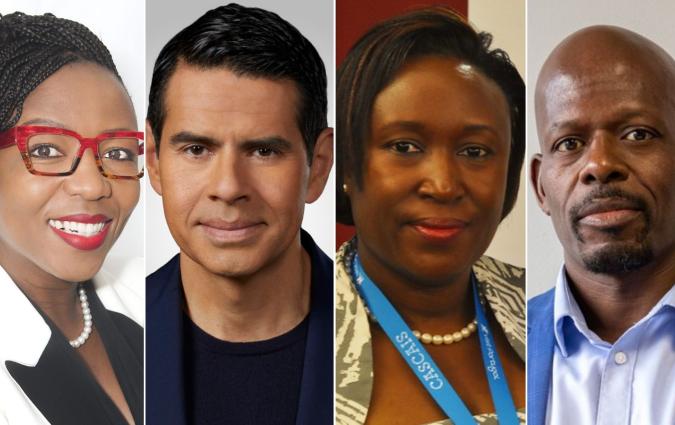In this piece
Race and leadership in the news media 2024: Evidence from five markets

Nwabisa Makunga, Sowetan; Terence Samuel, USA Today; Kimberly Godwin, ABC News; Amos Mananyetso, Daily Sun.
In this piece
Key findings | General overview | Methods and data | Findings | Conclusion | References | Acknowledgements | About the AuthorsDOI: 10.60625/risj-d119-xb11
Key findings
In this Reuters Institute factsheet, and continuing the work we began in 2020, we analyse the percentage of people of colour in top editorial positions in a strategic sample of 100 major online and offline news outlets in five different markets across four continents: Brazil, Germany, South Africa, the United Kingdom (UK), and the United States (US).
Looking at a sample of ten top online news outlets and ten top offline news outlets in each of these markets, we find:
- Overall, 23% of the 75 top editors across the 100 brands covered are people of colour, despite the fact that, on average, 44% of the general population across all five countries are people of colour. If we set aside South Africa and look at the four other countries covered, 9% of the top editors are people of colour, compared with, on average, 31% of the general population.
- In Brazil and Germany, as has been the case for the past three years, none of the outlets in our sample have a person of colour as top editor. In South Africa, we saw the percentage of top editors of colour drop from 80% in 2023 to 71%. In the US, the percentage of top editors of colour also decreased to 29%, compared with 33% last year. In the UK, 7% of those in top editorial positions are people of colour.
- As in previous years, in every single country covered, the percentage of top editors of colour remains below the percentage of people of colour in the general population.
- In the four countries where data are available on the number of journalists of colour, there continues to be no simple relationship between the percentage of journalists of colour and the percentage of people of colour in top editorial positions. In Brazil, there are fewer top editors of colour than there are journalists of colour. In the UK, these percentages are nearly the same. In South Africa and the US, there are more top editors of colour than journalists of colour.
- The share of internet news users who say that they read news from at least one major outlet with a top editor of colour ranges from 0% in Brazil and Germany to 90% in South Africa.
General overview
Who occupies top editorial positions in major news organisations is of both practical and symbolic importance. To the public, people in these roles often come to represent the news organisations they lead and the media industry at large. As key figures in the leadership and direction of news outlets, top editors model what journalism can and should be (Perreault and Tham 2023). They make decisions that influence what news and newsrooms look like, and their backgrounds and experiences are among the factors that influence such decisions (Duffy 2021). The racial and ethnic composition of newsroom management can shape diversity in hiring, retention, and promotion; the professional culture and norms within newsrooms; and news content itself, influencing editorial decision-making and attention to stories and experiences that reflect – well or poorly – the communities news organisations seek to serve (Jenkins and Powers 2023, Richardson 2022, Cruz and Holman 2022).
These premises are central to our ongoing work studying diversity in leadership in the news media, both from the perspective of gender (Ross Arguedas et al. 2024) and race (Eddy et al. 2023). We continue our work on race and ethnicity in news leadership here, documenting the diversity of top editors of major outlets to assess one aspect of how the news media industry has responded to conversations about racial justice, equity, and representation in many countries. Several years into the racial reckoning sparked by the murder of George Floyd and the Black Lives Matter movement, some warn that efforts promoting diversity and inclusion in newsrooms may be losing steam, a trend of particular concern following another year of mass layoffs in newsrooms around the globe, and which in some cases have hit journalists of colour particularly hard (see e.g. Bunn 2024; The Coalition for Women in Journalism and Women Press Freedom 2024).
This short factsheet accompanies important research by others working on race in the news media, including work gauging journalists’ perceptions of newsroom diversity (Boaventura Teixeira 2022; Gottfried et al. 2022), as well as studies documenting the challenges of under-representation, discrimination, and hostility faced by journalists of colour in predominantly white newsrooms (e.g. Al-Kaisy 2023; Oh and Min 2023; Jackson 2022).
Methods and data
Continuing our work from previous years (Andı et al. 2020; Eddy et al. 2023, 2022; Robertson et al. 2021), we focus on top editorial leadership positions in a strategic sample of five markets: South Africa in Africa, Germany and the UK in Europe, the US in North America, and Brazil in South America. These countries have different demographics and histories of white imperialism, colonialism, and slavery. To get an overview of similarities and differences across markets, as well as any changes in leadership, we examine the same countries in 2024 as we did in prior years. This choice of markets also allows us to leverage available data on the journalistic profession and on news and media use. We include five markets from those covered in Worlds of Journalism (Hanitzsch et al. 2019) and in the Reuters Institute Digital News Report 2023 (Newman et al. 2023).
Where it is possible, we compare our findings to data on racial and ethnic diversity in the journalistic profession (using Worlds of Journalism data collected between 2012 and 2016) and in the wider population (using the most recent census and other official data). However, data are not always available and comparisons not always possible, not only because of limited research, but also because of legal restrictions on collecting and retaining certain statistics on race (for instance in Germany).
Following work on the representation of race in editorial positions (Chakravartty et al. 2018) and citation patterns (Freelon et al. 2023) in communications research, we adopted a conceptualisation of race that contrasts institutionally dominant white populations and dominated racialised communities in order to call attention to the reification of racial categories as part of structural inequality and the exercise of power. This language and history differ across the countries we study, but what we are specifically referring to here are present-day hierarchies tied to colonial legacies of empire, militarism, and Apartheid. This year, and consistent with the shift we made last year, we have opted to use the terminology ‘people of colour’ instead of ‘non-white’ throughout our report in order to move away from references to a white default as well as to avoid terminology that in the South African context is associated with Apartheid.
As in the past, we want to be clear: race and racial discrimination work in complex ways not always tied to skin colour, for example where it has a religious dimension. They are the product of what has been defined as ‘racecraft’, categories in part produced by racist practices that in turn shape society and how we see it (Fields and Fields 2012). There are also some dimensions of ethnicity that are not related to conceptions of race. However, the conceptualisation we use here captures some important aspects of this in the countries we cover.
We therefore deploy a simple and reductionist, but hopefully still illuminating and relevant, binary, and code each top editor based on whether they are a person of colour or not. This coding was based on editors’ self-identification when publicly available as well as their biographies and images. Relying on physical appearance and biographies to analyse race is imperfect, as related research has noted (Freelon et al. 2023), so we also drew upon local partners’ expertise on differing contexts of race and ethnicity in each market we study here. Using the terminology ‘people of colour’ is in no way meant to suggest an identity, let alone a homogeneous group, given the great diversity and complexity of people’s identities. Rather, it provides a way to categorise otherwise very different people who come from institutionally dominated ethnic and racial groups. It helps us point to a dimension of inequality in representation at a macro level.
Our overall approach is identical to that of previous years. In each market, we focused on the top ten offline (TV, print, and radio) and top ten online news brands in terms of weekly usage, as measured in the Reuters Institute Digital News Report 2023 (Newman et al. 2023). When compiling the top ten lists, we only included specific brands, leaving out catch-all categories, such as ‘local news’ or ‘regional news’. We also excluded foreign news outlets that do not have newsrooms within the country of interest. Likewise, brands that ceased to exist following the publication of the Digital News Report 2023, such as BuzzFeed News, were excluded from the analysis. Adhering to these lists also means that news aggregator brands such as Yahoo! News are included in the analysis if they are (1) are widely used in that market (2) have local teams based there, and (3) produce at least some original content.
Our focus on the most widely used offline and online brands means that some important outlets with editors of colour are not included in the sample (in the UK, for example, the Financial Times, edited by Roula Khalaf, is not in the sample). Because of changes in what the most widely used brands are, and our focus on the top ten offline and online brands, there has been some turnover in the specific brands included in the analysis: 86 of the 100 brands covered in 2023 are included in the analysis again this year, with 14 new brands included.
For each brand, we identified the top editor by checking their official webpages, press releases, and related news coverage, alongside other public information, such as professional social media accounts (e.g. LinkedIn and X). The data were collected in February 2024. We looked for editor-in-chief or the nearest equivalent, for example, executive editor, or head of news for TV. The exact terminology varies from country to country and organisation to organisation, but in most cases, it is possible to identify a single person.
In some instances, brands on our lists belong to (or have been absorbed by) larger media groups or conglomerates. In such cases, we privileged the name of the person in the top leadership role at the level of the brand listed – rather than the entire group – or, in the case of media groups in South Africa with leadership organised around medium (e.g. radio) rather than brand, at the medium level. Likewise, when there appeared to be clear convergence between the offline and online version of a brand, with a single person steering the ship, we used the same top editor for both. However, when we identified a different person in charge of the online version of a brand, and especially when we understood this to be tied to distinct content and distinct editorial teams or decision-making, we used different names for the online and offline versions of the brand.
We have made some updates to our data set this year, as we’ve found new or better information about the person in the top editor role. This typically does not affect the coding, but on rare occasions, it can. This year we have one such instance in our South Africa data set, which slightly increases the percentage of women editors of colour in that country. This is worth keeping in mind when interpreting the data.
We refer to the individuals identified collectively as the top editors. It is important to note, of course, that this does not mean the top editor is the only person who matters or, in fact, is the most important person in terms of day-to-day editorial decision-making. We coded one observation as missing in cases where both online and offline versions of the same brand share a top editor as well as where two brands with the same ownership share a top editor, to avoid double-counting. Together, the analysis covers a total of 75 individuals across the 100 brands included in 2024, compared with 81 individuals in 2023. Some top editors had publicly or privately announced they were stepping down at or around the time of data collection. In these cases, where no replacement had been publicly announced by late February 2024, we chose to keep the outgoing top editor listed as is, and we include here the top editor as of late February.
The individuals identified were double-checked in consultation with local partners within every market, including current and former Reuters Institute Journalist Fellows as well as academic experts. In some cases, we also contacted the brands or their press offices to confirm who their top editor was. Where organisations responded, we always deferred to their judgement.
In a constantly evolving media environment, where many news organisations offer little or no transparency about who is actually in charge, it sometimes requires a qualitative judgement to determine who the top editor is. Indeed, in some cases where there is no single, clearly designated editor-in-chief, or roles and responsibilities across online and offline parts of the same outlet are unclear, we have made a judgement call as to who to code as the top editor of the outlet in question. We have tried to be as clear and consistent as possible about the criteria used to code an opaque and inconsistent world. The primary point of the factsheet is to capture the overall pattern even if in some cases individuals could have been coded differently.
All individuals in the data set were coded independently by the authors. Race and ethnicity are complicated phenomena, and so are statistics on race and ethnicity. What we present here is based on our coding of the individuals covered. Top editors may not in every instance see themselves in the same way, or always be seen by everyone else in the same way, though we prioritised editors’ self-identification when this information was publicly available. All the numbers presented here, both from our own data collection and from secondary sources we rely on, should be seen with this in mind.
Findings
Based on this data set, we find that 23% of the 75 top editors across the 100 brands covered are people of colour. This compares to 23% in 2023, 21% in 2022, 15% in 2021, and 18% in 2020. As in previous years, it is substantially below the, on average, 44% of people in the general population across all five markets who identify as people of colour (based on census data and other official estimates).1 It is also below the average percentage of journalists of colour (21%) in the four countries where we have available data (Hanitzsch et al. 2019). Setting aside South Africa, 9% of top editors across Brazil, Germany, the UK, and the US are people of colour, compared with, on average, 31% of the general population across these markets.
Looking exclusively at the 86 brands we covered in both 2023 and 2024, 23% of the top editors in 2024 are people of colour, the same as last year, despite some turnover among the top editors. Among the 11 new top editors identified and coded among these repeat brands, only one, in South Africa, is a person of colour. This is considerably lower than the same data point last year, when there were four editors of colour among the 15 new editors counted for 2023. Meanwhile, the percentage of top editors of colour among new brands included this year is even lower than among repeat brands, at 18%.
If we look at our data intersectionally and examine the gender composition of the sub-sample of editors of colour, we see that in South Africa, 67% of the editors of colour are men – closer to gender parity than last year, when the figure was 75%. This shift was the result of one staffing change plus an update to one data point alluded to in the ‘Methods and data’ section. Meanwhile, in the United States, we see a change in the opposite direction with a shift from 50% of men editors of colour to 75%, resulting from one staffing change and one brand with a woman editor of colour slipping off the list of top outlets. These market-level differences underscore the importance of tracking intersectional disparities to better understand structural inequalities in news leadership and the media industry more broadly (Banjac 2022; Lachover 2022).
As is clear from Figure 1, the percentage of top editors of colour varies considerably across the five markets analysed. In Brazil and Germany, as was the case in 2023, 2022, and 2021, none of the outlets we cover has a person of colour as top editor. In the other countries, where we had seen some improvements over the past two to three years, this year we find stagnation or small reversals in the trends. South Africa still has a majority of people of colour in top editorial positions, but the percentage is down to 71% this year (from 80% in 2023), the result of two new brands entering the top lists, both of which have white top editors. This brings South Africa close to its 2020 number (68%). In the US, the percentage of top editors of colour decreased slightly to 29% (from 33% in 2023), resulting from a reduction in the number of editors of colour (from six to four) and the smaller base this year (14 editors total compared to 18 last year).2 Meanwhile, in the UK, 7% of top editors in 2023 are people of colour, compared to 6% last year, due to a change in the total number of editors counted in the UK, but the number of editors of colour remained the same, at one person. (The overall percentage of top editors of colour remains the same despite drops in absolute numbers in some countries because of rounding and because the base number of editors in the sample is smaller than last year.)
Figure 1.
Relying on data from the Worlds of Journalism project collected between 2012 and 2016 (see Hanitzsch et al. 2019), shown in Figure 2, we compare the relationship between the percentage of people of colour working in journalism and the percentage of people of colour in top editorial positions across four of the five markets. (Data on the racial identity of journalists in Germany is not available.) Here, as in previous years, we find a mixed picture. The percentage of editors of colour is considerably higher than the percentage of journalists of colour in both South Africa (71% vs. 34%) and the US (29% vs. 9%).
Figure 2.
In Figure 3, we plot data on the demographics of the population as a whole and the percentage of top editors of colour in each market. As in previous years, we find marked disparities and an over-representation of white people among top editors across all five countries. The same as last year, the gap is largest in Brazil, where people of colour make up 57% of the population, yet there is not a single top editor of colour. In South Africa, the country with the highest percentage of editors of colour of our sample, we still find a 21 percentage-point gap relative to the percentage of people of colour in the general population (71% versus 92%), and which is up from the 12 percentage-point difference last year. In the US, at 29%, the percentage of top editors of colour remains below the 42% of people of colour (including Hispanic/Latinx) in the general population. After seeing this gap progressively shrink since 2021 in countries like South Africa and the United States, this year we have seen the numbers stabilise or reverse in the three markets where we had seen improvements, and in two markets with millions of citizens of colour, there continue to be no people of colour in top editorial positions at all.
Figure 3.
Finally, by combining the data collected for this Reuters Institute factsheet with data from the Digital News Report 2023 (Newman et al. 2023), we can identify the proportion of people in each market who access news from at least one major news outlet with a person of colour as top editor. In Figure 4, we show the share of online news consumers who say that they got news from at least one major outlet (online or offline) with a top editor of colour. The numbers vary considerably from country to country, but the numbers in 2024 are virtually identical to those from 2023. Audiences in Brazil and Germany still accessed no news in the past week from a major outlet included in our sample and edited by a person of colour, for the simple reason that there are no people of colour in top editorial positions among the outlets we cover. In the US, in 2024, 42% of online audiences used at least one source with a top editor of colour, close to the 41% that did in 2023. In the UK, 5% of online audiences accessed news from at least one major news outlet with a person of colour as top editor, the same as last year. In South Africa, the figure shrank just one percentage point from 91% in 2023 to 90% in 2024.
Figure 4.
Conclusion
In this Reuters Institute factsheet, we have analysed the racial breakdown of top editors at a strategic sample of 100 major online and offline news outlets in five different markets across four continents. After a couple of years of gradual improvements in some markets in our sample, this year we find stagnation and small reversals, as our topline figure remains on par with last year, and the two markets driving most of the change saw decreases for the first time in the last two to three years, while a third market remained nearly unchanged. In addition, it continues to be the case that there are no top editors of colour in our sample of brands in two other countries, one of which has a majority of people of colour in the overall population.
In our fifth year tracking these trends across five markets, we continue to find that people of colour are significantly under-represented, and white people are significantly over-represented as top editors, relative to their share of the general population in all five countries.
The lack of progress we find this year, and so soon into the latest reckoning around racial justice, equity, and representation in the news media, offers support to the concern expressed by some in the industry that diversity, equity, and inclusion (DEI) initiatives focused on race and ethnicity are losing steam and lagging behind efforts to reduce gender disparities (Cherubini and Sharma 2023). Sceptics of the latest DEI boom, including veteran journalist and co-founder and CEO of URL Media, S. Mitra Kalita, have called out the diversity initiatives of the last three years for being ‘largely cosmetic, performative, and perfunctory’.3 This perception is shared by some journalists and audiences from minoritised groups, who express wariness towards newsroom diversity practices that come across as tokenistic and disingenuous (Al-Kaisy 2023; Ross Arguedas et al. 2023) – less concerned with improving journalistic cultures and outputs than with favourable PR.
It is also worth remembering that research consistently finds that people from minoritised groups often feel misunderstood and misrepresented by the news media, and the belief that news is not made by or for people like them – or worse yet, is complicit with systems of oppression – contributes to low levels of trust in news (Ross Arguedas et al. 2023; Peterson-Salahuddin 2023).
Keeping racial and ethnic diversity at the forefront of industry conversations and within newsrooms, especially at trying times for news organisations, will not happen without an express intention and commitment to do so. While many continue to work hard to make this happen, it is not clear from our most recent data that progress is still being made, and there is a real risk that we will see further stagnation or backsliding.
We will know more when we repeat this analysis next year and publish new data tracking developments in race equality among top editors across the world.
References
- Al-Kaisy, A. 2023. Structural Racism in UK Newsrooms. London: Ethical Journalism Network.
- Andı, S., Selva, M., Nielsen, R. K. 2020. Women and Leadership in the News Media 2020: Evidence from Ten Markets. Oxford: Reuters Institute for the Study of Journalism.
- Banjac, S. 2022. ‘An Intersectional Approach to Exploring Audience Expectations of Journalism’, Digital Journalism, 10(1), 128–47.
- Boaventura Teixeira, L. F. 2022. The Human Impact of Racial Representation in Brazilian Newsrooms. Oxford: Reuters Institute for the Study of Journalism.
- Bunn, C. 2024. ‘Journalists of Color Hit Hard in Seismic L.A. Times Layoffs’, NBC News, 24 January. (Accessed Mar. 2024)
- Chakravartty, P., Kuo, R., Grubbs, V., McIlwain, C. 2018. ‘#CommunicationSoWhite’, Journal of Communication, 68(2), 254–66.
- Cherubini, F., Sharma, R. 2023. Changing Newsrooms 2023: Media Leaders Struggle to Embrace Diversity in Full and Remain Cautious on AI Disruption. Oxford: Reuters Institute for the Study of Journalism.
- Cruz, C. Y., Holman, L. 2022. ‘The Media and Race in the Trump Era: An Analysis of Two Racially Different Newsrooms’ Coverage of BLM and DACA’, Howard Journal of Communications, 33, 197–215.
- Duffy, A. 2021. ‘Out of the Shadows: The Editor as a Defining Characteristic of Journalism’, Journalism, 22, 634–49.
- Eddy, K., Selva, M., Nielsen, R. K. 2022. Race and Leadership in the News Media 2022: Evidence from Five Markets. Oxford: Reuters Institute for the Study of Journalism.
- Eddy, K., Ross Arguedas, A., Mukherjee, M., Nielsen, R. K. 2023. Race and Leadership in the News Media 2023: Evidence from Five Markets. Oxford: Reuters Institute for the Study of Journalism.
- Gottfried, J., Mitchell, A., Jurkowitz, M., Liedke, J. 2022. Journalists Sense Turmoil in their Industry amid Continued Passion for their Work. Washington, DC: Pew Research Center.
- Hanitzsch, T., Hanusch, F., Ramaprasad, J., de Beer, A. S. (eds). 2019. World of Journalism: Journalistic Cultures around the Globe. New York: Columbia University Press.
- Jackson, T. L. 2022. ‘Stories that Don’t Make the News: Navigating a White Newsroom as a Black Female Reporter’, Journalism Practice, 1–16.
- Jenkins, J., Powers, E. 2023. ‘Listening, Reflecting, and Protecting: Empathy as a Priority for Local Journalists Covering Underserved Communities’, Journalism Practice, 1–18.
- Lachover, E. 2022. ‘Ethiopian-Israeli Women Working in Mainstream Journalism: Linking Ethiopian, Black and Israeli Identities through News-Making’, Journalism, 23(10), 2041–59.
- Newman, N., Fletcher, R., Robertson, C. T., Eddy, K., Nielsen, R. K. 2023. Reuters Institute Digital News Report 2023. Oxford: Reuters Institute for the Study of Journalism.
- Oh, D. C., Min, S. J. 2023. Navigating White News: Asian American Journalists at Work. New Brunswick, NJ: Rutgers University Press.
- Perreault, G. P., Tham, S. M. 2023. ‘Effective Leadership in Journalism: Field Theory in How Journalists Evaluate Newsroom Leadership’, Journalism, 0, 14648849231222694.
- Peterson-Salahuddin, C. 2023. ‘Trust Signals: An Intersectional Approach to Understanding Women of Color’s News Trust’, Media and Communication, 11(4), 332–43.
- Richardson, R. J. 2022. ‘Local TV Newsroom Diversity: Race and Gender of Newscasters and their Managers’, Journal of Broadcasting & Electronic Media, 66, 823–42.
- Robertson, C. T., Selva, M., Nielsen, R.K. 2021. Race and Leadership in the News Media 2021: Evidence from Five Markets. Oxford: Reuters Institute for the Study of Journalism.
- Ross Arguedas, A., Banerjee, S., Mont’Alverne, C., Toff, B., Fletcher, R., Nielsen, R. K. 2023. News for the Powerful and Privileged: How Misrepresentation and Underrepresentation of Disadvantaged Communities Undermines their Trust in News. Oxford: Reuters Institute for the Study of Journalism.
- Ross Arguedas, A., Mukherjee, M., Nielsen, R. K. 2024. Women and Leadership in the News Media 2024: Evidence from 12 Markets. Oxford: Reuters Institute for the Study of Journalism.
- The Coalition for Women in Journalism and Women Press Freedom. 2024. ‘United States: Journalists of Color Disproportionately Affected by Major Media Layoffs’, 24 January (press release). (Accessed Mar. 2024)
Footnotes
1 For information about the general population we have relied on official data where possible, namely 2022 census data published by the Brazilian Institute of Geography and Statistics, 2022 mini-census data published by the Federal Statistical Office in Germany, 2022 census data published by Statistics South Africa, 2021 census data published by the UK Office for National Statistics in the UK, and 2020 census data published by the US Census Bureau. Race and ethnicity do not have the same history or work the same way in all these countries, a complexity we set aside here to enable cross-national comparison. German law prohibits the collection of official statistics about ethnic categories. To arrive at an approximate figure for comparison, we have aggregated census data on households with a Middle Eastern/Northern African/Central Asian, Sub-Saharan African, East Asian and South/Southeast Asian, and other/unspecified/mixed migrant background.
2 More specifically for the US, when looking at personnel changes amongst brands included last year, none of the new editors were of colour; meanwhile, two of the four new brands included this year had an editor of colour, but it was the same person, so he was counted only once.
Acknowledgements
The authors would like to thank Luiz Fernando Boaventura Teixeira, Kirsten Eddy, Camila Mont’Alverne, Nic Newman, Mpho Raborife, Anne Schulz, and Felix Simon for their valuable time, input, and feedback.
About the Authors
Amy Ross Arguedas is a Research Fellow at the Reuters Institute for the Study of Journalism.
Mitali Mukherjee is the Director of the Journalist Programmes at the Reuters Institute for the Study of Journalism.
Rasmus Kleis Nielsen is the Director of the Reuters Institute for the Study of Journalism and Professor of Political Communication at the University of Oxford.

This report can be reproduced under the Creative Commons licence CC BY.





